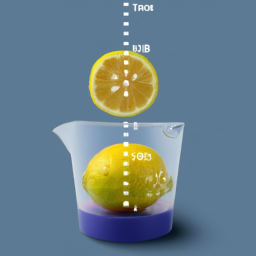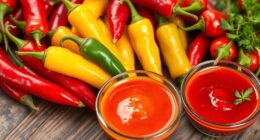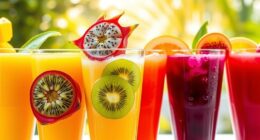As someone who loves kicking off their day with a refreshing cold glass of orange juice, I have frequently pondered about how much juice is in one orange. It is worth mentioning that oranges differ in their level of juiciness – some are more fruitful in juice than others, and there are various factors that can affect the amount of juice you can extract.
In this article, I’ll delve into the science behind orange juice content and provide some tips on how to get the most juice out of your oranges.
Firstly, it’s important to understand that the amount of juice in an orange can vary depending on several factors, such as the variety of orange, its ripeness, and the conditions in which it was grown. Additionally, the way you extract the juice can also impact the amount you get.
By exploring these factors, we can gain a deeper understanding of how to get the most juice out of our oranges and make the most out of this delicious fruit.
So, let’s dive in and uncover the secrets of the orange!
Key Takeaways
- Orange juice content varies based on the variety, ripeness, and growing conditions.
- Valencia and blood oranges have higher juice content compared to Navel oranges, which have thicker skin and lower juice content.
- Rolling the orange and using a citrus press or mesh strainer can increase juice yield, with a medium orange yielding 1/3 cup and a large orange yielding up to 1/2 cup.
- Juicing removes some nutrients and fiber, and oranges are a good source of vitamin C, fiber, potassium, folate, and hesperidin, with potential health benefits such as reducing the risk of heart disease and lowering cholesterol levels.
Factors that Affect Juice Content
You’ll want to know what factors affect the juice content of an orange. After all, who wouldn’t want to maximize the juice yield when squeezing fresh oranges for a morning glass of OJ?
Well, one of the primary factors affecting juiciness is the variety of orange. Some varieties, such as Valencia and blood oranges, are known for their high juice content, while others like navel oranges tend to be less juicy.
But it’s not just about the type of orange. Other factors that can impact juice content include the age of the fruit, the region it was grown in, and the amount of rainfall it received during the growing season. For example, oranges grown in dry regions with consistent sunshine tend to have lower juice content than those grown in more temperate, humid climates.
With these factors in mind, it’s important to choose the right type of orange for your juicing needs. Now, let’s explore the different types of oranges and their unique characteristics.
Types of Oranges
The tangy taste of tangerines tantalizes the taste buds. Oranges come in various types, each with unique characteristics, from flavor to size and color. Here are four varieties of oranges that you may encounter in the market, each with its specific cultivation techniques and juice content.
-
Navel Oranges: These are the most common type of orange in the United States. They get their name from the small, navel-like formation on their blossom end. Navel oranges have thicker skin, which makes them easier to peel, and they are seedless. They’re also known for their high juice content, making them an excellent choice for juicing.
-
Valencia Oranges: These oranges are the most commonly grown type worldwide. They have thin skin and are smaller than navel oranges. Valencia oranges are sweet and juicy, and they’re often used for juicing because of their high juice content.
-
Blood Oranges: These oranges are smaller than navel oranges and have a distinctive red color. They get their name from the bright red color of their flesh, which is due to the presence of anthocyanin, a type of antioxidant. Blood oranges have a unique flavor, which is slightly tart. They’re also high in juice content, making them ideal for juicing.
-
Seville Oranges: These oranges are bitter and sour, and they’re rarely eaten fresh. Instead, they’re primarily used for making marmalade and other preserves. Seville oranges have a high pectin content, which makes them ideal for making jams and jellies. They also have high juice content, but their sour flavor makes them less desirable for juicing.
As we’ve seen, different types of oranges have varying characteristics, including their cultivation techniques and juice content.
In the next section, we’ll delve deeper into the juice content of different types of oranges.
Juice Content of Different Types of Oranges
One may be surprised to learn that the juice content of Valencia oranges is higher than that of navel oranges. According to my research, Valencia oranges have an average juice content of 53.5%, while navel oranges have an average juice content of 45.5%. However, it is important to note that the juice content of oranges can vary depending on the specific variety and the juicing technique used.
To better understand the juice content of different orange varieties, I have created a table below comparing the juice content of Valencia and navel oranges:
| Orange Variety | Juice Content |
|---|---|
| Valencia | 53.5% |
| Navel | 45.5% |
As shown in the table, Valencia oranges have a higher juice content compared to navel oranges. However, this does not necessarily mean that Valencia oranges are always the better choice for juicing. Other factors such as taste preference and availability should also be considered when choosing an orange for juicing.
Moving forward, it is important to consider the best techniques for extracting the most juice from oranges. These tips will be discussed in the next section.
Tips for Getting the Most Juice Out of Oranges
Maximizing the potential of your citrus fruit can be achieved by implementing certain strategies that are known to increase yield. To get the most juice out of an orange, it’s important to use the right orange squeezing techniques.
One effective technique is to roll the orange on a hard surface before squeezing. This helps to break down the membranes inside the fruit, allowing the juice to flow more freely. Another helpful tip is to use your hands to apply pressure evenly on different parts of the orange while squeezing.
Aside from using traditional juicers, there are also alternative methods to extract juice from oranges. For example, using a citrus press can be effective in extracting more juice than simply squeezing the fruit with your hands. Additionally, using a mesh strainer can help to remove any pulp or seeds that may be present in the juice.
By implementing these tips and utilizing different juicer alternatives, you can get the most juice out of your oranges and enjoy the full flavor and nutritional benefits they have to offer.
Moving on to the next section, let’s explore how to calculate the amount of juice in an orange.
How to Calculate the Amount of Juice in an Orange
To accurately measure the liquid content of an orange, it’s helpful to cut the fruit in half and use a juicer or press to extract the liquid.
Calculating juice yield requires measuring the orange size, determining the weight of the fruit, and then extracting the juice to determine the volume of liquid produced.
The amount of juice in an orange can vary depending on the size of the fruit and its ripeness. On average, a medium-sized orange contains approximately 1/3 cup of juice, while a large orange can yield up to 1/2 cup of juice.
By accurately measuring the amount of juice in an orange, you can ensure that you have enough liquid for recipes or for drinking.
Now, let’s explore other uses for oranges.
Other Uses for Oranges
You can do more with oranges than just eating them, like adding a burst of sunshine to your morning smoothie or using the zest to add a zing of flavor to your cooking, like a pinch of salt to a dish.
Oranges are a versatile fruit that can be used in many recipes, from sweet to savory. For example, you can use freshly squeezed orange juice in marinades for meats or seafood, or in salad dressings for a tangy flavor. The zest of an orange can be used to flavor cakes, cookies, and even cocktails.
In addition to their delicious taste and versatility in the kitchen, oranges also provide numerous health benefits. They’re a great source of vitamin C, which is essential for a healthy immune system and can also help with the absorption of iron. Oranges also contain fiber, which can help with digestion and keep you feeling full longer.
So next time you’re in the grocery store, consider picking up a bag of oranges to add some variety to your meals and improve your health.
Did you know that oranges were first cultivated in China over 4,500 years ago? Or that they’re the largest citrus crop in the world? These interesting facts about oranges and more will be explored in the following section.
Interesting Facts About Oranges
I find it fascinating to discuss the historical significance of oranges, as this fruit has played an important role in human history. Oranges have also made their way into popular culture, appearing in movies, songs, and literature.
Additionally, there are many fun facts about oranges. For example, they’re not always orange in color and they can grow on both trees and shrubs.
Historical Significance of Oranges
The humble orange has played a significant role in history, from its origins in Southeast Asia to its widespread cultivation and trade throughout the world. The citrus trade, which began in the 12th century, brought oranges to Europe, where they were initially grown for medicinal purposes. As orange cultivation techniques improved, the fruit became more widely available and was eventually used for culinary purposes.
To understand the impact of oranges, it’s helpful to consider some data. Below is a table showcasing the top orange-producing countries in the world, as of 2020:
| Rank | Country | Production (in metric tons) |
|---|---|---|
| 1 | Brazil | 17,000,000 |
| 2 | China | 12,000,000 |
| 3 | India | 9,500,000 |
The historical significance of oranges is undeniable, but their impact on popular culture is just as noteworthy. Without giving away too much, let’s just say that oranges have found their way into countless songs, films, and TV shows.
Oranges in Popular Culture
From the iconic opening scene of The Godfather to the famous Orange Crush soda commercials, oranges have become a ubiquitous symbol in popular culture.
Oranges have been used in movies and literature to convey a range of emotions and themes, from joy and happiness to death and destruction. In The Godfather, the oranges that fall to the ground foreshadow the impending death of the character played by Marlon Brando. Similarly, in the novel One Hundred Years of Solitude by Gabriel Garcia Marquez, oranges are used as a symbol of love and passion.
Oranges have also been used in advertising, with the Orange Crush soda commercials featuring the slogan ‘Crush it!’ and showing images of oranges being crushed to make the drink. Oranges have also been used as a symbol of health and vitality, with advertisements for orange juice emphasizing the vitamin C content and the health benefits of consuming oranges.
Overall, oranges have become an important part of popular culture and continue to be used in a variety of ways to convey different messages and meanings.
As we move on to the next section about fun facts about oranges, it’s important to note that oranges have played an important role not just in pop culture, but also in history and agriculture. From their origins as a hybrid fruit in Southeast Asia to their widespread cultivation around the world, oranges have a rich and fascinating history.
Fun Facts About Oranges
Did you know that oranges are a great source of nutrition? One medium-sized orange contains about 70mg of vitamin C, which is more than the recommended daily intake for adults. Oranges are also rich in fiber, potassium, and folate, making them a healthy addition to any diet.
Aside from being a great snack, oranges are also versatile in the kitchen. They can be used in a variety of recipes, from salads to desserts. Some popular orange recipes include orange chicken, orange marmalade, and orange sorbet. With their sweet and tangy flavor, oranges can add a burst of freshness to any dish.
Speaking of oranges, there are some common myths about them that are simply not true. For example, some people believe that eating too many oranges can cause heartburn, but in reality, oranges are not acidic enough to cause any discomfort.
In the next section, I will debunk some more myths about oranges.
Common Orange Myths Debunked
You might be surprised to learn that some of the most popular beliefs about oranges are actually myths. For example, thinking that squeezing an orange will give you a glass of juice with the same amount of Vitamin C as eating the whole fruit is not accurate. In fact, the process of juicing removes some of the nutrients and fiber found in oranges.
Additionally, the amount of juice you can get from one orange can vary depending on the size and ripeness of the fruit. On average, one medium-sized orange can yield about 1/3 to 1/2 cup of juice. To further debunk some myths about orange nutrition, here are three surprising health benefits of oranges that you may not know:
- Oranges are a good source of potassium, which can help lower blood pressure.
- Oranges contain hesperidin, a flavonoid that has anti-inflammatory and antioxidant properties.
- Eating oranges may reduce the risk of heart disease, as they are high in fiber and have been shown to lower cholesterol levels.
So, next time you reach for a glass of orange juice, remember that the whole fruit is always the better choice for overall nutrition and health benefits.
Frequently Asked Questions
What is the nutritional value of orange juice?
As a nutritionist, I highly recommend incorporating orange juice into your daily diet due to its numerous benefits. Varieties such as freshly squeezed or fortified with calcium offer essential vitamins and minerals, including vitamin C and potassium.
How long does it take for an orange to produce juice?
Squeezing an orange by hand produces juice in seconds, but commercial juice extraction methods may take longer. Factors such as fruit maturity, temperature, and processing equipment can affect orange juice yield.
Can you use frozen oranges to make juice?
Yes, frozen oranges can be used to make juice. However, the juicing techniques may differ from fresh oranges. It is important to thaw the oranges first and consider the impact on taste and texture.
What is the best way to store oranges to maximize juice content?
To maximize juice content, storing oranges in the refrigerator is best. Rolling them on a hard surface before juicing can also increase yield. Using a citrus juicer is the most efficient technique for extracting juice.
Is it better to hand-squeeze oranges or use a juicer for maximum juice yield?
To achieve maximum yield, juicing oranges is more efficient than hand squeezing. Studies show that juicers can extract up to 20% more juice than manual squeezing, resulting in a higher yield and less waste.
Conclusion
In conclusion, the amount of juice in an orange can vary depending on several factors such as the type of orange, its ripeness, and the method used to extract the juice. Valencia oranges are known to have the highest juice content, while blood oranges have a lower juice content due to their pigmentation. To get the most juice out of an orange, it’s recommended to roll it on a hard surface before squeezing it, and to use a citrus juicer if possible.
Interestingly, oranges have many uses beyond just being a source of juice. They can be used in cooking, as a natural air freshener, and even as a cleaning solution. Oranges are also a great source of vitamin C and other important nutrients.
So next time you enjoy a glass of orange juice or snack on a juicy orange, remember all the hidden benefits and uses of this versatile fruit.
Ilana has been a vegan for over 10 years. She originally made the switch for health reasons, but soon found herself becoming more and more passionate about the ethical and environmental implications of a vegan lifestyle. Ilana is the author of The Graceful Kitchen, a blog all about veganism. She loves to cook up delicious and nutritious vegan meals, and share her recipes with others who are interested in leading a cruelty-free life. Ilana is also a strong advocate for using whole foods as the foundation of a healthy diet, and believes that going vegan is one of the best ways to achieve this.










